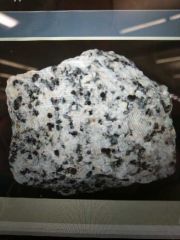![]()
![]()
![]()
Use LEFT and RIGHT arrow keys to navigate between flashcards;
Use UP and DOWN arrow keys to flip the card;
H to show hint;
A reads text to speech;
59 Cards in this Set
- Front
- Back
- 3rd side (hint)
|
LIST EARTHS LAYERS FROM TOP TO BOTTOM (Chemical) |
Continental Crust Oceanic Crust Mantle Core |
COMC |
|
|
EARTHS LAYERS TOP TO BOTTOM (MECHANICAL) |
Lithosphere Asthenosphere Mesosphere Outer core Inner core |
LAMOI |
|
|
Continental Crust |
Felsic (light) 30-70km Silicon Oxygen Sodium Potassium Aluminum Calcium Potassium feldspar Mica Quartz |
|
|
|
Oceanic Crust |
Mafic (Dark) 3-10Km Silicon Oxygen Iron Calcium Pyroxene Amphiboles Plagioclase feldspar |
|
|
|
Mantle |
2900 Km Silicon Oxygen Iron Magnesium |
|
|
|
Core |
3400km Iron Nickel |
|
|
|
Lithosphere |
Includes Crust and uppermost mantle) 100-150km |
|
|
|
Asthenosphere |
250km |
|
|
|
Ocean Ocean subduction Zone |
Backarc Rift |
|
|
|
Ocean Continent Subduction Zone starting from forearc what can be seen from an airplane and what can't? |
1. Trench (underwater) 2. Accretionary prism (depends on height) 3. Forearc basin (low lying) 4. Volcanic Arc (seen) 5. Fold/thrust belt 6. Foreland basin |
|
|
|
Why isn't he ocean deeper around the edges than it is at mid ocean ridges? |
Isostasy |
The crust is hot at mid ocean ridges and has no mantle lithosphere weighing it down, away from ridges it's colder and heavier more mantle freezes and weighs it down. |
|
|
Clastic |
Formed from clasts (fragments) of weathered rocks |
|
|
|
Biogenetic |
Formed from fragments of life forms (shells skeletons etc) Reacts to hydrochloric acid |
|
|
|
Chemical |
Formed by crystallization of dissolved minerals as water evaporates |
|
|
|
Felsic |
Light colored High silica |
|
|
|
Mafic |
Dark colored Low silica |
|
|
|
Transgression leads to |
Smaller grain size over time |
|
|
|
Regression leads to |
Larger grain size over time |
|
|
|
Rift basin |
Long and narrow Tall mountains on one or both sides |
|
|
|
Foreland basin is... |
Long and wide |
|
|
|
Passive margain basin |
Extremely deep (Coastal) |
|
|
|
Basin |
Low lying area where sediment can accumulate |
|
|
|
Volcanic Hazards include |
Pyroclastic flow Lahars Lava flows Toxic gas Ash fall Volcanic blast Earthquakes and landslides |
|
|
|
You can predict a volcano imminent irruption by |
Looking for changes in Earthquake activity Heatflow Ground movement and shape Gas emissions |
|
|
|
Igneous rocks are classified |
According to minerals composition and grain size |
|
|
|
Decompression melting |
Decrease in pressure on hot rock causes it to melt |
|
|
|
Flux melting |
Adding water to mantle decreases melting point of mantle rock |
|
|
|
Where does flux melting occur? |
Subduction zones |
|
|
|
Heat Transfer melting |
Add heat until melting point is reached |
|
|
|
Where does decompression melting occur |
Mantle ploom |
|
|
|
Fractional Crystallization |
Some magma freezes eliminating some minerals and leaving others - leaves magma more felsic |
|
|
|
Assimilation |
Hot magma melts surrounding rock contamination the magma with new minerals |
|
|
|
Two types of volcanoes |
Shield And Composite |
|
|
|
Composite volcano |
Relatively small Very tall and steep Usually light colored lava Violent eruptions of thick sticky lava |
|
|
|
Shield volcano |
Very large Broad gentle slopes Gentle eruptions |
|
|
|
Pelean and plinian eruptions |
Powerful and explosive |
|
|
|
Surtseyan |
Water erupts with seawater |
|
|
|
Dry magic magma leads to and occurs in |
Gentle eruptions Mid ocean ridges Oceanic hotspots |
|
|
|
Wet felsic magma leads to and occurs in |
Violent eruptions Ocean Subduction zones |
|
|
|
Batholith |
Frozen magma chamber |
|
|
|
Pyroclastic flow |
Quickly moving avalanche of lava and hot gasses |
|
|
|
Lahars |
Mud flow travels very quickly carrying large debris |
|
|

|
Rhyolite Fine grained
Quartz Potassium feldspar Plagioclase feldspar Biotite Amphiboles |
Rhyolite |
|

|
Granite Coarse Grained
Quartz Potassium feldspar Plagioclase Biotite Amphiboles |
Granite |
|

|
Dacite Fine Grained
Quartz Sodium rich plagioclase feldspar Amphiboles |
|
|

|
Granodiorite Coarse Grained Sodium rich plagioclase feldspar |
|
|

|
Diorite Coarse / intermediate composition Quartz No potassium feldspar |
|
|

|
Andesite Fine Grained Intermediate comp Quartz No potassium feldspar |
|
|
|
Gabbro |
Coarse grained Mafic comp No quartz Pyroxene Plagioclase feldspar (calcium rich) |
|
|
|
Basalt |
Fine Grained Mafic comp No quartz Pyroxene Plagioclase feldspar (calcium rich) |
|
|
|
Alluvial fans |
High energy to flat gradient Stream loses energy and dump sediment |
|
|
|
Delta |
Alluvial fan in the ocean
Current/wave dominated
River dominated (bird foot)
Tide dominated
|
|
|
|
Ripples are formed in |
Low to medium current |
|
|
|
Planer bedding |
Formed in low or VERY high current |
|
|
|
Assymetric ripples |
Flowing in a river |
|
|
|
Symmetric ripples |
Tidal flats |
|
|
|
Crossbedding |
Forms in eolian (wind) sand dunes |
|
|
|
Graded bedding |
Forms in under water landslides |
|
|
|
Sea leveling falling |
Grain size increases over time |
|

